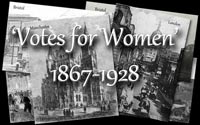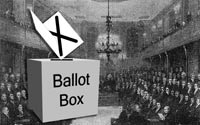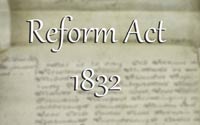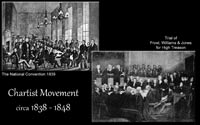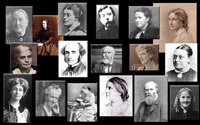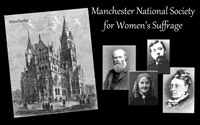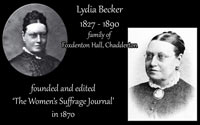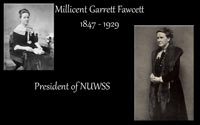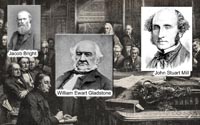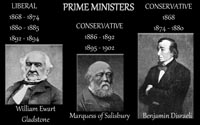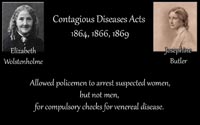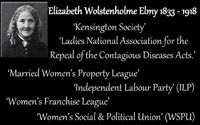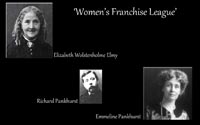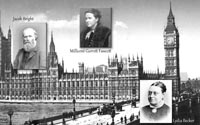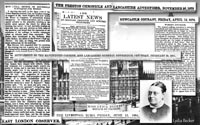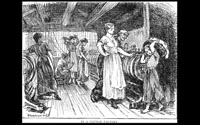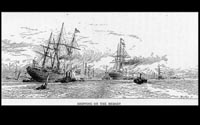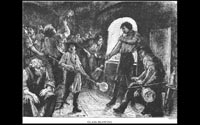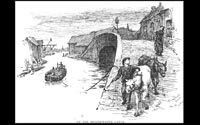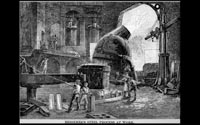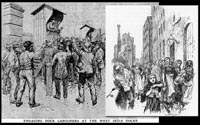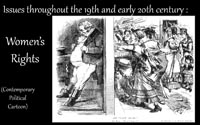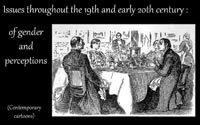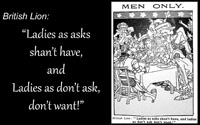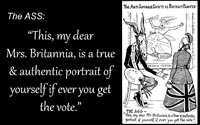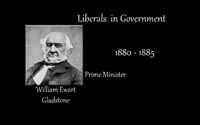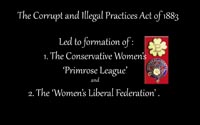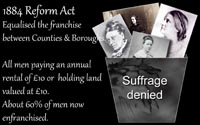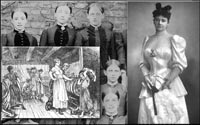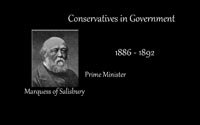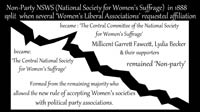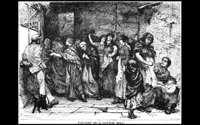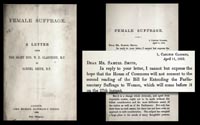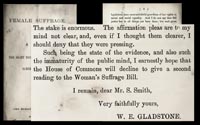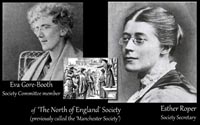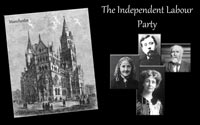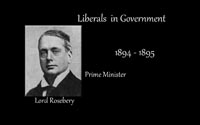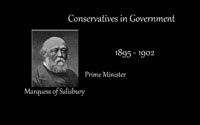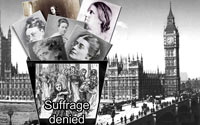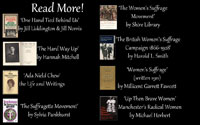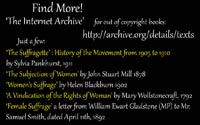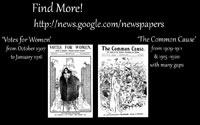
"VOTES FOR WOMEN!" - |
||
CHRONOLOGY of events Opens in a new window |
||
PART 1 .......... 1867 - 1900 |
||
A few facts, first: Women were subject to Coverture, under which a married woman had no rights or legally recognised separate identity from that of her husband. Suffrage is the right to vote in political elections. The Franchise determined the qualification needed in order to have the right to vote. |
||
The 1832 Reform Act had extended suffrage for men ........... actually took away an implicit right of women householders to vote, that had been understood under Common Law. Prior to the 1832 very few women had exercised this right to vote so it was 'tidied away' in 1832 and tthe franchise was henceforth for 'male persons'. One of the main arguments put forward by women at this time was that the original right be re-instated in law. |
||
Unlikely as it may seem, in the earlier years of the 19th century there had been short-lived groups of radical women, particularly in Lancashire, who had seen their need and right to have a Parliamentary vote. Initially supported by early Chartists this claim was 'lost', as being too radical for any real support and replaced by one of 'suffrage for all men' (which was only slightly less radical by a 'whisker'!) |
||
The story properly starts in the mid 19th century when groups of intelligent, well-educated women came together to debate the current issues of the day. Their concerns weren't just about suffrage but about women's rights, or lack of them, across the board. They were women who were stifled by the social dictates of the times and wanted to use their skills and education in the professions. They saw the injustice of the many acts of law which discriminated against women financially, socially and professionally and wanted to change things. One of these groups was the Kensington Ladies Discussion Society formed in 1865 and at its second meeitng Barbara Boichon read a paper on suffrage after which almost everyone voted in favour. |
||
The first of the new Suffrage Societies was formed in radical Manchester, in the January of 1867. Not long afterwards the Kensington Group became the London Suffrage Society and the following year the Manchester, London and Edinburgh Societies were affiliated, forming a loose federation known as the National Society for Women's Suffrage (NSWS), and were joined the following year by the Bristol Society. The committee, made up of representatives from the federated societies would co-ordinate the regional activities |
||
When John Stuart Mill had been elected to parliament his election address had included a plea for women's suffrage. At his request Barbara Bodichon and her allies gathered together 1500 signatures on a petition which was presented to parliament in 1866. His ammendment to the Reform Bill, when it was debated, proposed that women householders should be included in the franchise. Hardly unexpectedly the ammendment was thrown out as a 'joke' but the subsequent Reform Act of 1867 used the term 'man' instead of the more usual 'male person'. This was to be seen as a loophole by suffragists as, in another Act of Parliament, it had been decided that the word 'man' was a generic term for 'mankind' ie., to include women unless specifically stated otherwise. |
||
Lydia Becker, whose grandfather and family lived at Foxdenton Hall, Chadderton, had been to a lecture in Manchester and heard Barbara Bodichon read a paper on 'Reasons for the Enfranchisement of Women'. Lydia knew that she had found a cause that gave new meaning and purpose to her life. It was Lydia Becker who, looking for ways to extend the franchise to women, found a woman who had inadvertently been added to the register of electors. Lydia encouraged her to vote in the 1868 General Election, on the basis of the term 'man' including women. Her vote was reluctantly accepted. Capitalising on this Lydia encouraged as many women ratepayers as she could to register on the 1868 electoral roll. In some towns they were accepted but in others rejected ............ Manchester, where almost 4,000 women claimed their right to vote, was one that denied the women's claim. Appeals against the adverse decision were taken to the High Court and in a test case Richard Pankhurst was one of the defence barristers, arguing impressively and knowledgeably to support the women's claims. Battle lines appeared to have been drawn. |
||
|
In 1870 Lydia Becker founded the 'Women's Suffrage Journal' whch she edited until her death in 1890. Passionate about education for girls she she was elected to the first Manchester School board using all her influence to improve the quality of their schooling and curriculum. The rest of her time was devoted to campaigning for women's suffrage and recording it in the columns of her journal.. The 'voice' of Women's Suffrage in the 19th century was the NSWS, the 'National Society for Women's Suffrage' with Lydia Becker as its Secretary. |
|
Millicent Garrett Fawcett was one of the very few women who were there at the beginning and would live to see women gain equal voting rights with men, in 1928. Born in 1847, she was the wife of the pro-suffrage Liberal MP, and cabinet minister, Henry Fawcett and was the sister of Elizabeth Garrett Anderson who became the first woman doctor in England. She joined the London Suffrage Society in 1868 and spoke at her first public meeting the following year ........... the first of many. |
||
To set the scene ................. In 1868 Conservatives were in office and Disraeli was the Prime Minister. There was to be a General Election ......... and a contemporary cartoon didn't appear to think the Liberals had much hope! |
||
However, the Liberal Party gained a majority and formed a government with Gladstone as the Prime Minister, Much to the dismay of the suffragists, though, John Stuart Mill lost his seat in Parliament ............ However, all was not lost as the Liberal MP Jacob Bright took on the role of champion of Women's Rights, in Paliament. |
||
The first real chink in the armour of male domination came in 1869 with the Municipal Corporations (Franchise) Act. This Act incorporated Jacob Bright's ammendment which gave women the right to vote in local elections on the same basis as men. Only widowed, or single women rate-payers, were enfranchised but, importantly, it set a precedent that led to enfranchised women being granted the right to vote for, and be members of, the local school boards when they were established in 1870. |
||
Still in 1870 and Jacob Bright introduced the first Women's Suffrage Bill, proposing women be given the vote on the same terms as men. It passed it's 2nd reading but was defeated when Gladstone opposed it at the committee stage by invoking 'Party Loyalty' in support of his opposition. This sort of manipulation by any PM happened at every stage, throughout the 19th century, whenever it appeared that an ammendment or bill would pass a second reading or get to the committee stage |
||
Politics in the last 30 odd years of the 19th century was dominated by three Prime Ministers: At this time there was no Labour Party or other 3rd Party in opposition but Scotland, Ireland and Wales had representative MPs, who could swing a ballot. |
||
One of the first major splits in Women's Sufrage policy, and the society, came in 1871 Although suffragists were united in their desire to secure the vote, for women, there was never complete unity about 'HOW' it would be achieved and WHO should get it. The almost exclusively middle class women, with strongly held opinions, found that when compromise might be necessary, they weren't always willing to do so. One such example was that concerning the Contagious Diseases Act. However, it discriminated against women, as the legislation contained no clause to protect women from being infected by men with the disease. Elizabeth Wolstenholme and Josephine Butler led the campaign, for repeal, against this legislation. There was some sympathy for the cause but many women, including Millicent Fawcett, felt that open support would be detrimental to the Suffrage movement, and the Society decided not to be associated with the campaign However, some of the women felt this repeal to be so fundamentally important, for Women's rights in general, that they joined the LNA (The Ladies National Association for the Repeal of the Contagious Diseases Act), some going onto the committee. |
||
It's probably appropriate, here, to say a little more about Elizabeth Wolstenholme Elmy, who was a prominent figure in the cause of Women's suffrage but who illustrates just how diverse the separate causes for Women's Rights could be. She is, perhaps, not as well known as some others - probably because she championed those other women's causes just as passionately.
However, by 1912 she had written to the Manchester Guardian voicing her deep concerns about the 'madness' of the WSPU which could wreck the whole cause of women's suffrage. She died in 1918 and lived just long enough to see Women at least get a partial vote. |
||
In these same 30 years, or so, the main Suffragist Societies were organised on a non-party basis. Suffragist tactics, until the turn of the century, relied heavily on lobbying MPs to convince them of the justice in giving women the vote and also of the ways in which it made sense to include women in government. At first this just caused laughter, scorn and disbelief amongst the politicians. But, as the years passed, more and more back-benchers were won over to the cause of Women's Suffrage and numerous petitions, bills and ammendments were introduced in parliament. Although they were persistent, and dogged in their determination, their behaviour was considered to be more or less acceptable for women at that time even though their actual aims were viewed with either derision or hostility by most men. Suffragist opinions, and activities, were widely reported in the press, thereby keeping public awareness of the movement high and having influence on voters at election time. |
||
The suffragists also relied heavily on the 'power of the pen' to gain public interest and support. When we search the newspapers of these years, for the well known suffrage names of the day, there are dozens of references ranging from the national editions to local rags. During these years pressure in Parliament was constant and there were 15 separate Bills and Resolutions, supporting Women's suffrage, put before the House............ and a fair number gained enough support to reach a second reading. Always, though, they were the victims of unwavering opposition from Disraeli, Salisbury and Gladstone |
||
|
There were also the not-so-flattering cartoons, which appeared in the newspapers and journals, featuring the more well-known protagonists, in this case Lydia Becker and MP Jacob Bright.. |
|
The Women's Suffrage movement was growing in both strength, influence and numbers against a background of rapid industrial invention and commercial expansion in: |
||
|
................ to name just a few. |
||
'Votes for Women' was the all embracing cry but it was only one aspect of the Women's Rights movement of the 19th century and was sometimes 'diluted' by the attention given to other important issues that were sometimes seen to be more achievable or of more relevance and importance, . However, there were several real stumbling blocks to progress, some of which remained as serious issues until well into the 20th century. First, and foremost, were the generally held opinions by the vast majority of men, and even of a fair number of women, that : Another major political stumbling block was defining, to everyone's satisfaction, just what exactly Suffragists were asking for and WHO would or would not benefit if just some, or all women, had the vote. Whilst elements of Coverture were still in force, the right to vote, if given to even a minority of women, opened up a whole new 'can of worms' and was a blow to male domination, as far as men were concerned. Knowing that a radical franchise wouldn't even be contemplated, many women, although not all, accepted that limited suffrage would be a necesary first 'step on the ladder'. |
||
A further hurdle was that of party loyalty when MPs were called on to vote. All too frequently, if an ammendment was seen to threaten a party's electoral majority, then party loyalty was demanded from the MPs . MPs frequently protected personal ambition, at the cost of their stated principles. |
||
Class loyalty became an increasingly important issue towards the end of the 19th century. Initially women's suffrage had been demanded at a time when even most men didn't have the vote. By the end of the 19th century, 60% of men were enfranchised and working class women were beginning to have, through their union activities, more political awareness and were Going against their their perceptions of status and position could be a 'bitter pill' for some women to swallow ....... |
||
A recurring theme throughout the suffrage campaign was that of the, 'carrot of Women's suffrage' being dangled by Parliamentary leaders, as a reward for support in election campaigns which, when the election was successfully over, was then whisked away with some vague excuse or even an unashamed denial. |
||
From beginning to end, women suffragists were the subject of verbal abuse or derision; They were patronised as not having the sense or sensibilities necessary for a person to vote wisely; |
||
In 1880 there was a General Election. |
||
Three years later, in 1883, as a result of the 'Corrupt Practices Act', the Political Parties needed the help of women as never before. They were necessary as the legally acceptable, unpaid volunteers to work in supporting the Parliamentary election campaigns. The Conservative women became known as the 'Primrose League' This involvement strengthened women's beliefs that they should be enfranchised. |
||
In 1884 A further Reform Bill was debated and ammendments for Women's suffrage were again introduced. Gladstone, always a fierce opponent of women's suffrage was the Liberal Prime Minister. An ammendment, which was perceived to swell a potential Conservative electorate, was rejected. This was a bitter blow for suffragists as there was, by now, some considerable cross-party support for women's suffrage in principle if not always in practice. |
||
At this point the class structure was still very rigid and there was little real sense of 'female solidarity'. Societies fighting for a variety of other women's causes (for example those supported by Elizabeth Wolstenholme Elmy), tended to have suffrage as a 'second string' or not even on their agenda at all. Men had gained greater influence by coming together in unions to support demands in the workplace and the largest unions had thrown their support behind certain MPs who would, in return, promote their interests and support their demands, in the House. |
||
In 1886 there was a General election in which the Conservatives were returned in office, with the Marquis of Salisbury as the Prime Minister. |
||
One of the NSWS rules was that the Society should not accept the affiiliation of political pary organisations. Millicent Fawcett and Lydia Becker, were in agreement that societies affiliated to the NSWS should remain strictly non-party and not allow any Political Associations to become affiliated. In 1888, this became a major issue when a number of the NSWS members voted to change the rules and, thereby, the ethos, Millicent Garrett Fawcett and Lydia Becker, with their supporters formed a new organisation, as the Central Committee of the NSWS (confusing!!), remaining on a non-party basis. The remaining members became 'The Central NSWS' and allowed the affiliation of politically associated women's societies. |
||
Following on from this, in 1889, the Women's Franchise League, committed wholly to also enfranchising married women, was formed by Elizabeth Wolstenhulme Elmy, Richard & Emmeline Pankhurst and Ursula Bright . It became the voice of ultra radical suffragsim, with a different ethos, and saw the need to link up with the growing labour movement and working class women activists. |
||
Generally, the men's trade unions were as hostile to Women in either the unions or having the Parliamentary vote, as any other layer of society. However, working class women, who were all too frequently refused a voice in men's trade unions, seeing what could be achieved when they banded together, followed the men's example and began to form their own unions, calling for better pay and conditions in the workplace and safeguarding the interests of women workers. Working class involvement in suffrage grew significantly as women union-activists began to be sent as delegates to the Trade Union Council and began to realise how much advantage they could gain, in their own camapaigns, if they also had the vote. |
||
In 1892, Gladstone, despite again dangling carrots of promised suffrage support, before the coming General election, made it very clear, privately, to a fellow MP, that Women's suffrage was definitely not on his personal agenda for reform The loyalty of the Women's Liberal Federation was seriously tested when Gladstone made his suffrage views more public. The Federation was split as the pro-suffrage members took control but 7 thousand of those members. with their greater loyalty to the Party, left to form another association. |
||
A chink in the armour of male domination came with reform of the Local Government franchise. By 1894 Married Women's Property Acts and a Local Government Act had largely removed the issues of coverture and gave all women, married or otherwise, (albeit within the property franchise) the right to elect, and also to stand for election, for parish councils, district councils, school boards and Poor Law Guardians. Within the franchise, Women could vote in council & borough elections but only be elected to sit on rural district councils. It would be 1907 before women could sit on Borough or County councils. |
||
1894 was also significant in that The Women's Co-operative Guild, which campaigned for women's rights in the workplace, formally endorsed Women's suffrage at their Annual Conference, and the North of England Suffrage Society, in Manchester, under the leadership of Eva Gore Booth and Esther Roper, threw all their efforts into involving working class women and their unions in the suffrage movement. |
||
The 1890s was the decade that saw Keir Hardie elected to Parliament where he would support Women's suffrage through 'thick and thin' right up to his death in 1915. It also saw the founding of the Independent Labour Party (the ILP) in Manchester, of which Elizabeth Wolstenholme Elmy, Emmeline and Richard Pankhurst became members. The ILP would be the springboard from which Emmeline Pankhurst would found the Women's Social and Political Union, from which the militant Suffragettes would emerge. |
||
In 1894 Gladstone retired and Lord Rosebery, at the invitation of Queen Victoria, became Prme Miinister. |
||
In 1895 there was a General election; the Conservatives gained power and the Marquess of Salisbury, became Prime Minister. |
||
In 1897, in a massive re-organisation, many different suffrage groups came together under the banner of the NUWSS, a federation of the largest suffrage societies. It was under the leadership of Millicent Garrett Fawcett and an elected executive committee, with authority, directing rather than co-ordinating the federation's policies and activities. The stated aim of the NUWSS was 'to obtain Parliamentary suffrage for women on the same terms as it is, or may be, granted to men' |
||
It's often written that nothing seemed to be happening for women's suffrage in the half dozen years around the turn of the century, but, more recently, research has shown that although there was little apparent Parliamentary activity on suffrage there was a steady growth in support as women started to come together in female solidarity, slowly helping to outweigh any social and party loyalty differences. As a new century came in women's suffrage must have seemed almost as far away as it had ever been although the will to achieve it was as strong as ever. |
||
Main Reference Sources (text list with on-line links to individual, free-to-read books and journals) |
||
Suffrage MENU PAGE
